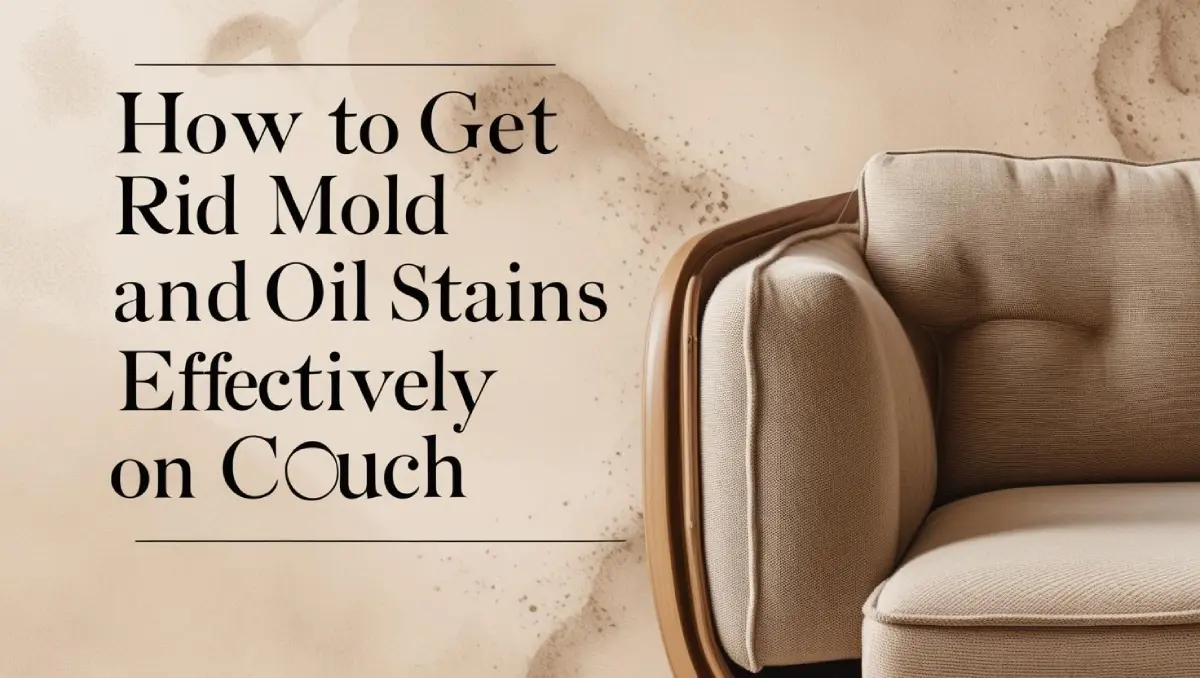Furniture is one of the most valuable and frequently used assets in your home. From relaxing on the couch to working at your desk or enjoying dinner at the table, furniture supports much of daily life. However, it also faces frequent wear and tear. Spills, humidity, pet accidents, and food messes can all lead to two of the most stubborn problems: mould and oil stains.
Whether you’re dealing with a mildewed armchair or a greasy patch on your sectional, this comprehensive guide will help you understand how to get rid of mould on furniture and how to get oil stain out of couch fabric—safely and effectively.

Why Mould and Oil Stains Are a Big Problem for Furniture?
Mould and oil stains are not just unsightly—they’re damaging. Mould can pose health risks like respiratory issues, while oil stains seep deep into upholstery, attracting dirt and causing discoloration.
Common Causes:
-
Mould often grows in damp, poorly ventilated spaces or on furniture that has been exposed to moisture (like outdoor chairs or furniture near windows).
-
Oil stains may come from food spills, body oils, hair products, or greasy hands and feet.
Let’s break down how to deal with each issue using proven methods.
How to Get Rid of Mould on Furniture?
Mould thrives on organic materials—wood, fabric, and even some finishes. Getting rid of it requires a balance between effectiveness and fabric safety.
Step 1: Safety First
Before starting, wear gloves and a mask, and open the windows for ventilation. Mould spores can become airborne and cause allergic reactions or other health problems.
Step 2: Identify the Affected Area
Check for signs such as:
-
Musty odor
-
Green, black, or white patches
-
Dampness or discoloration
If the mould has penetrated deeply or affected cushions and padding, professional cleaning or replacement may be necessary.
Step 3: Vacuum and Brush
Use a HEPA-filter vacuum to remove loose spores from the surface. Then, brush off as much mould as possible using a soft-bristled brush.
Step 4: Clean with Vinegar or Alcohol
White vinegar is an excellent natural mould killer.
-
Mix equal parts white vinegar and water in a spray bottle.
-
Spray the affected area generously and let it sit for an hour.
-
Blot with a clean cloth and allow it to dry in the sun if possible.
Alternatively, you can use rubbing alcohol or a store-bought anti-mould solution, especially for delicate fabrics or wooden furniture.
Step 5: Dry Thoroughly
Mould loves moisture. After cleaning, make sure to dry the furniture completely. Use fans, sunlight, or a dehumidifier.
Preventive Measures
-
Use a dehumidifier in humid climates.
-
Keep furniture away from walls to promote air circulation.
-
Regularly clean and inspect high-risk areas.
Knowing how to get rid of mould on furniture can preserve its condition and protect your family’s health. Don’t ignore even small mould spots—they can spread quickly if untreated.
How to Get Oil Stain Out of Couch Upholstery?
Oil stains are notorious for being persistent and highly visible, especially on fabric couches. The key is acting quickly and using the right absorbent and degreasing agents.
Step 1: Blot the Excess Oil
Use paper towels or a dry cloth to blot as much oil as possible. Avoid rubbing—it spreads the oil further into the fibers.
Step 2: Use an Absorbent Powder
Sprinkle baking soda, cornflour, or talcum powder on the oil stain. Let it sit for 30 minutes to absorb the grease.
Then, vacuum or gently brush off the powder. You may already see some improvement.
Step 3: Apply Dish Soap Solution
Mix a few drops of grease-cutting dish soap with warm water. Use a sponge or cloth to apply the solution to the stained area. Gently blot—don’t scrub. Let it sit for 5–10 minutes.
Blot the area with a damp cloth to remove any soapy residue.
Step 4: Repeat if Necessary
Some oil stains may require two or more rounds of cleaning. If the stain persists, you can try a commercial upholstery cleaner designed for oil or grease.
Step 5: Air Dry
Let the couch dry naturally or speed things up with a fan. Make sure it’s completely dry before using it again.
Learning how to get oil stain out of couch fabric can save your furniture from premature ageing and keep your home looking fresh and clean.
Natural Alternatives for Mold and Oil Removal
If you prefer eco-friendly methods, here are a few homemade solutions:
-
Mould:
-
Tea tree oil and water (10 drops per cup)—natural antifungal
-
Hydrogen peroxide (3%)—kills mould on contact, but test on fabrics first
-
-
Oil:
-
Lemon juice and baking soda—good for light fabrics
-
White vinegar solution—effective for both odor and stain removal
-
Always spot-test on a hidden area first to ensure no discoloration occurs.
Maintenance Tips to Prevent Future Issues
-
Vacuum regularly to keep dirt and oils from building up.
-
Use fabric protectors like Scotchgard to make spills easier to clean.
-
Clean spills immediately, especially food and drink.
-
Keep furniture dry, and avoid placing it in humid or poorly ventilated areas.
-
Rotate cushions and pillows to prevent uneven wear and oil build-up.
Conclusion
Understanding how to get rid of mould on furniture and how to get oil stains out of couch surfaces is essential for maintaining the cleanliness, safety, and longevity of your furniture. While these stains may seem intimidating, with the right tools, techniques, and a bit of elbow grease, most can be managed effectively at home.
For persistent or large-scale problems, don’t hesitate to bring in professional help—sometimes investing in expert care can save you from having to replace costly furniture.
